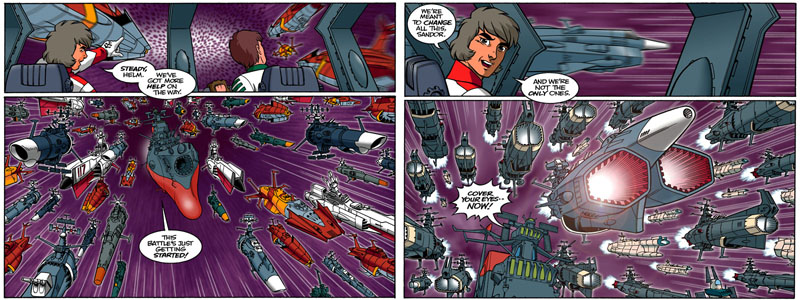
As I write these words, it’s been just a few days since I put the finishing touches on the last page of the last chapter, and it already seems like it happened in another life. That’s the way it usually is with a big project that takes over your world. You spend months on end focusing all your available energy on it, stealing hours from other things, bending and twisting your calendar around it until everything else seem less important. And then suddenly one day it’s over. This can be a moment of great liberation or crashing disarray. Or both. Either way, it’s a good time to clear your thoughts, so here goes.
I’ve already written about the genesis of Star Blazers Rebirth in The Making of Chapter 12 feature, so now I’d like to talk about some of the things I experienced during the two years it took to pull this story out of my head and transform it into pixels.
First I should say that I certainly didn’t intend for it to take over my life. When I initially estimated that I only had to generate the equivalent of half a color comic book every 60 days it seemed like child’s play. At the peak of my comics career I could squeeze that much out in just a couple of weeks. So from that angle it seemed like the whole project could be accomplished with very little effort.
Then I started on Chapter 0 and it all changed in a heartbeat. I suddenly remembered how much I loved working on the Star Blazers comics all those years ago for Argo Press and also how much I love the world of Yamato. It’s a very rich and detailed universe that took a long time to visualize, and you can’t do it justice with very little effort. So when my pencil first hit paper, my fate was sealed. This was going to be a full-time job. In fact, it turned into more than that. I never kept count of the actual hours I put in every week, and I would be very surprised if it was a mere 40. I’m sure I invented some extra hours along the way.
Please keep in mind, I already HAD a full-time job that kept my bills paid. I’m lucky enough to have a freelance animation storyboard career that allows me to work at home, which means my hours are flexible. I’m also lucky enough to draw for a living (something I’d do for free if necessary) so in the end it doesn’t really feel like work. Without that saving grace, I’d probably be just a smear on the pavement by now.
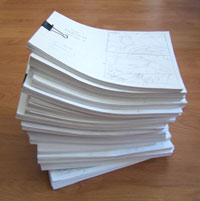
At left: all the artwork from all 18 chapters in one teetering mass. (Okay, it’s only about 9″ high, but still!) Because of the webcomic format, I could draw everything on regular old 8.5 x 11 which is much easier to handle than 10×15″ Bristol board. (Try finding a cheap scanner that can take 10×15! And then tell me about it, because I want one!)

At right: Some of the story notes I kept throughout the production. They started out clean and neat, but every time a new idea popped into my head I scribbled it into the margins. Sometimes I just grabbed whatever paper was closest, like a napkin or a used envelope. Some chapters became so complex I could only work them out them by shifting post-it notes around until I found the right order of events. As crazy as all this might look, it was the most enjoyable part of the whole process.
When I told a friend (and Rebirth devotee) about the impending wrapup, he wrote the following in response: “I’d be pleased if there might be more later, but what’s in it for you? In the sense of pouring your heart and soul (and time and money) into such a work and having nothing to show for it except the art itself. Wow. It’s pretty awesome when I think about it.” He’s right on one level, since the finished art is the only real physical artifact of all that effort. But any time I bury myself in a big project like this I get plenty of intangible rewards for my devotion, and they balance the ledger quite well.
Prior to this project, Star Blazers and Yamato had already pretty much become my second job. Between the DVD production, regular updates for the website, and making the documentary, I always had some sort of Star Blazers or Yamato project on my plate. This meant I was on a constant lookout for vintage merchandise from Japan, since everything offered the potential for something new (or at least a new way of looking at something old). When I got to the end of the documentary project I thought I ‘d found just about everything an American could get. But then, a few months after starting Rebirth I was introduced to the Yahoo Japan auctions. (Sound effect here: GONGGGGGG!)
If you haven’t experienced these yet, let me tell you they are next best thing to a tour of all the dusty collector’s shops you imagine must exist in Tokyo. In the space of a few minutes the world of Yamato merchandise exploded in my face, showing me things I’d only dreamed about. Music, books, videos, toys, books, cards, games, books, magazines, fanzines, and most importantly books, books, books! The old scavenger’s instincts bubbled up again and my collector’s fury burned with the white-hot brilliance of a million blazing suns. Between all the new discoveries on Yahoo and my daily immersion into Star Blazers Rebirth it was just like the emcee said at the last big Yamato concert in 1983: “Yamato is what it means to be young.”

Here you see most of my Yamato book collection (the paperbacks, videos, music, models, etc. are on other shelves).
Before I got introduced to the Yahoo.jp auctions, it was only half as wide.
Another unexpected thing that happened around this time was my re-entry into anime fandom via the internet. I still had loads of friends from younger days, but I hadn’t followed them into the realm of message boards and chat sites, choosing instead to focus on work and see my pals only on rare occasions. That all changed when Rebirth got off the launch pad and netted me several invitations to rejoin the party. Now I’m just as immersed in it as I ever was, and this too continually ignites the energy of youth.
But I have to say, the very best part of the entire process was getting fan mail. I’ll make no bones about it, I LOVE the fan mail. I’ve probably said this before but it bears repeating: most people like me work in a vacuum most of the time where most of the communication is between your brain and hand. The prolonged lack of contact with other human beings makes you wonder if anyone “out there” knows or cares what you’re up to and if your work could possibly be as meaningful to them as it is to you. That describes nearly every comics project I did prior to this one. Because Rebirth was a webcomic, it finally gave me a chance to experience the chapter-by-chapter feedback an artist craves and thrives on. It was a consistent reminder that the work DID touch the lives of others, and their encouragement to continue was the fuel in my tank.
As a side note, I was especially pleased to hear from folks who had seen Star Blazers years earlier but had never tuned in to anime fandom. They had essentially come in from the cold to learn that their old favorite was still alive and well, and I was honored to welcome them back to the campfire.
Other rewards this project brought me had to do with the production process. Writing the individual scripts was always the best part, since it was the one chance I had to experience them “fresh.” Wrestling the scrambled DNA of story ideas to the ground and binding them up in dialogue was tremendous fun, and it gave me a constant motivator to finish the current chapter so I could figure out what everybody was going to say next. The finishing part wasn’t quite as enjoyable, though.
Don’t get me wrong, I love to draw and I especially love the fact that so much of the Yamato universe was already designed for me, but the act of transforming scripts into pictures can get pretty tedious. It goes garden-snail slow, and when it finally reached your eyeballs I had already drawn everything four times over: thumbnail sketch, rough pencils, tight pencils, and then ink. Then came the assembly and the color. It’s all worth it in the end, of course, but those individual stages often seemed like they might never end.
That’s why lucky accidents and unanticipated discoveries are the lifeblood of this or any artform-they keep the mechanical stuff from taking over. In order to explain what I discovered on this project, I have to get a little technical. So please bear with me and I’ll try to make it painless.
The key to telling an engaging story in comics is just like any other form: timing. Putting it simply, you release information to a reader in a structured, methodical sequence. It’s a little like letting the air out of a balloon and trying to control the pitch of the whistle. If you lose your grip, the balloon shoots erratically around the room with a big wet farty sound. That’s what we call “poor storytelling.” How does one control timing with words and pictures on a page? By carefully manipulating the space they take up. When you get good at this, you can tell a reader’s eyeball exactly where to look and how long to dwell on any particular spot. And here’s what nobody wants you to know: the greatest secret weapon in our arsenal is the bottom of a page. Any writer worth their salt will build up (or rather down) to that point and find some way of making you want to turn to the next page. Then it starts all over again.
Now, in a comic book you can usually see two full pages at a time. Despite what I just said above, we can’t stop you from looking across both pages if you’re determined to do so. We’d prefer that you just take in one panel at a time, but we’re not standing there holding you in a headlock, so we our best to direct you with the layout. But we know you can’t see across more than two pages at once, so we usually plan a surprise for you on the very next page, right after the turn. It may be a little thing like the punchline to a joke or a big thing like an exploding universe, but either way it’s all ours until you turn the page. And we LOVE piling on the suspense for you. It makes us feel either like Santa Claus or the neighborhood bully, depending on the mood of story.
When I asked David Wu (the illustrious webmaster of starblazers.com) to suggest a format for the webcomic, he gave me measurements that were exactly half of a comic book page. Usually we draw comic pages at 10×15 inches and shrink them to 60% for printing. A Rebirth page measures 10×7.5 inches, which means if you stack two of them together they add up to 10×15. So I had to learn how to design layouts in half-page spurts. I thought they would eventually be re-assembled into standard comic book pages and published as a graphic novel, so that’s how I organized them.
But then came the big discovery. Remember how I said that you can usually see two full pages at a time in a comic book? This webcomic would be completely different–you could only see ONE at a time. Even better, you could only see HALF of one at a time. For me, this meant that every single layout had a built-in page-bottom, which meant that EACH ONE would lead up to that magic turn. In other words, I had four times as many opportunities to deploy the secret weapon. I don’t know if anyone other than a comic book creator can understand just what a monumental discovery that is. And I can tell you right now, it makes printed comic books a lot less fun to write by comparison.
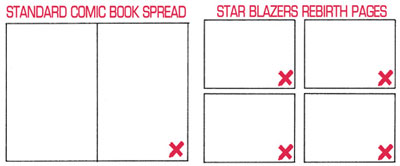
At right: In case my talk of the “secret weapon” still has you scratching your head, here’s a diagram to illustrate it. The X shows you where the secret weapon is located.
If you’re not completely bored yet, I’ll throw some more technobabble at you. Prior to this project, the last time I got to do a full-color comic book was (fittingly) the Argo Press Star Blazers comics that closed down ten years ago, waaaay back in ’97. Color adds a lot more time to the job, but I’m sure you agree that it’s worth it. Besides, color on a computer screen is practically free whereas color on paper is often prohibitively expensive.
So when I decided Rebirth would be presented in color, it instantly dictated how I had to draw the pages. In pre-digital days the technique of coloring comic books was quite limited so the artists didn’t have to do much to accommodate it. It’s completely different now, where a zillion special effects can be used to enhance the artwork. To take full advantage of them (while still keeping to a tight schedule) requires splitting up the artwork into multiple levels, very much like animation cels.
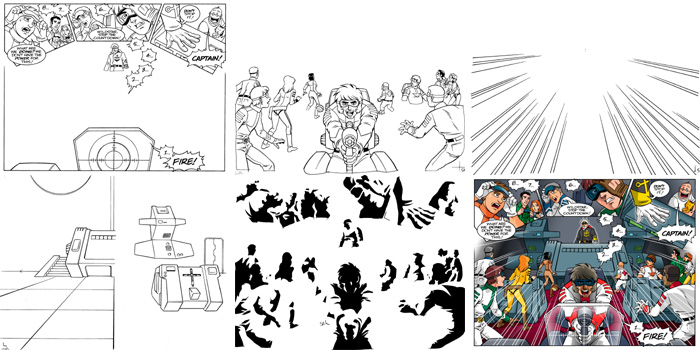
Here are all the components of a typical page. Some pages were simpler, others were more complex.
All of them had to be scanned and assembled piece by piece. First row: foreground layer, mid-ground
characters, effects layer. Second row: background layer, shadow holdout layer, finished composite.
The impact of this on Rebirth meant that very few (if any) of the pages are complete from top to bottom. Any time I wanted to add a special effect or an unusual color treatment to an object, the process required that object to be drawn on its own piece of paper and scanned separately. Taking it a step further, this usually meant that anything BEHIND that object would need its own layer as well. Then there was my library of spaceship art (a valuable holdover from the Argo Press comics) that already existed as independent files, not to mention a huge, poster-sized image of the Argo’s bridge that I could use as often as I wanted since there was no need to redraw it. (See? Just like cel animation.)
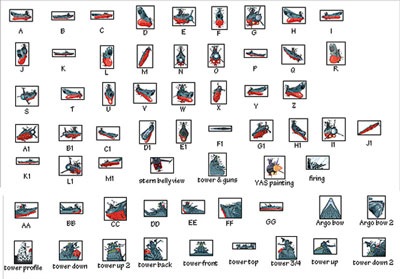
At left: a glimpse at my library of re-useable Yamato art, which I started back in the Argo press days. During the course of Rebirth I added about 60% of what you see here.
Hopefully you’re starting to get a sense of how complex this became. And I haven’t even told you yet about the shadow holdout layer, which was a set of outlines for each page that dictated where the shadows fell on the character drawings. Add all this up and it gets to be less like comic book art and more like a jigsaw puzzle. The thought that kept haunting me all the way through was that if my life ended somewhere in the middle of a chapter, nobody in the world would know how to piece it together. Fortunately for all of us, I’m still here.
Believe it or not, the purpose of all this layering was to speed up the process so I could produce each chapter as quickly as possible. Any extra time it took to draw all those separate layers was more than balanced out once it was composited in Photoshop and all the special effects could be applied with minimal fuss. Which brings me to the silliest and most technical point of all, one which only real computer geeks will appreciate. Ready? All this work was done in Photoshop 3.0. I’ll say that again. 3.0. Now I’ll pause to let you blink in wonder a few times.
There. So why did I use 3.0 when we’re already on something like version 9 or 10? Simply put, 3.0 was the first one I learned, it’s the one I’m still most comfortable with, and only it would allow me to work at my top speed. However, Rebirth was probably the last thing I’ll ever do in 3.0. See, during the two years it took me to produce all 18 chapters, my trusty old Mac G3 passed from the “venerable” category into the realm of antiques. All sorts of tremendous leaps were being made in the world of Apple computers, and as long as I was committed to the G3 there was no way for me to enjoy them. (It was one of the few Macs left that could run Photoshop 3.0, just in case I didn’t make that point clear enough for the non-geeks reading this.)
But all that changed when I hit “save” for the last time and promptly went out to buy a slick new imac. It’s a beautiful powerhouse of a machine, and I’m sure it will make my next webcomic look even better (of COURSE I’m going to do another one, they’re too much fun!), but there will always be a special place in my heart for the old grey-and-aqua-blue friend whom I could always rely on. Okay, enough tech-talk. Back to the real world.

Here’s the old G3 side-by-side with the new imac.
Yeah, I know. Shut up.
I’ve also got some flesh-and-blood friends to thank before I sign off, so here goes. First, thanks to Ed Hawkins for tuning me in to the Yahoo.jp auctions where all that treasure was lying in wait. Next, thanks to Keith Johannsen of Musashi Enterprises for stepping in with an entirely different treasure horde of rare books that provided invaluable reference material. I also have to thank Anime World Order for having me on episode 14 of their excellent podcast and reintroducing me to the world of anime fandom on the net.
Then there was Star Blazers superfan Derek Wakefield whose razor-sharp critiques of the early chapters told me how to re-focus some of the later ones. Similar thanks go to Carol Hutchings, matron of Dessloktoberfest, who stepped up at just the right time to clue me in on the Iroze character (who was created for the first Yamato TV series but never used) and giving me other great ideas without even knowing it. Then there were the artists and writers whose contributions to chapter 12 made it even more mind-blowing than I’d hoped it would be. (See The Making of Chapter 12 for more about them.) Lastly, I have to thank my patron, Barry Winston of Voyager Entertainment, who gave the project an immediate green light back in ’05 and trusted me implicitly to carry the Star Blazers banner into new territory. Without the generous and timely help of these fine people, Rebirth would not have lived up to its full potential. I may look back on it in a few years and think I could have done it better, but right now I couldn’t be more satisfied.
Finally, I want to thank each and every one of you who took the time to write in and share your appreciation. In return, I made it my job to put a smile on each of your shiny little faces, and it sounds like everything worked out.
-Tim Eldred, July 2007
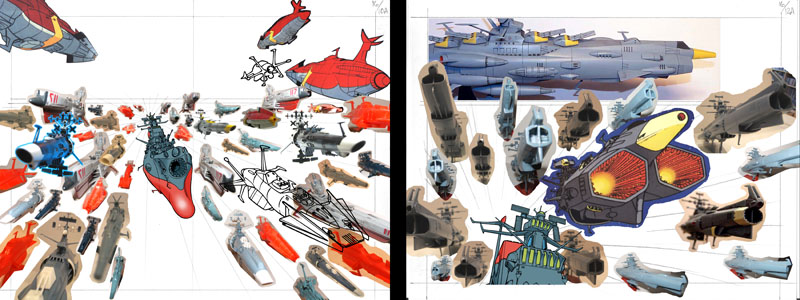
When my library came up dry I could occasionally fall back on my model kit collection. This was a lifesaver on chapter 16.
By sheer dumb luck, it turned out I had every single EDF ship in my personal vault, so with a little help from a digital camera, some very difficult pages became manageable. I wish I could have done this for every page, but some Yamato model kits simply don’t exist, even today.
